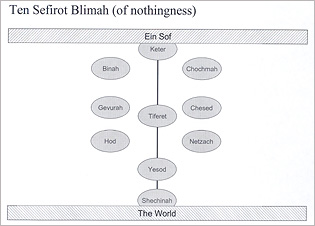by Sharon Brock
After a spate of popularity in the 1970s, Kabbalah, an aspect of Jewish mysticism, has once again become fashionable. But do its tenets have any relevance to health care providers?
For Dr. Tsvi Bar-David, an interfaith chaplain in San Francisco, the answer is a definite yes. And on May 12, he explained to UCSF students how health care providers can apply facets of Kabbalah to healing. The lecture was sponsored by the UCSF
Jewish Students Association.
Dating back nearly 2,000 years, Kabbalah - meaning "to receive" in Hebrew - is a belief system regarding the nature of divinity, the creation of the world and the role of human beings. Described in the 13th-century book
The Zohar, or "Book of Splendor," Kabbalah also consists of meditative, devotional, mystical and magical tradition, which is why it is regarded as an esoteric offshoot of Judaism.
In his lecture, Bar-David took a practical approach to Kabbalah and explained how the Ten Sefirots of Light and Darkness can be used for healing. The Sefirots are conceptual, three-dimensional spheres which are specifically arranged in a treelike formation in a theoretical space between heaven and earth.
The Tiferet is the central balancing sphere of this "Tree of Life" and represents equilibrium. Tiferet is located on the vertical line that separates the idea - on a "layer" -of contraction, or Gevurah, on the left side, and expansion, or Chesed, on the right.
The other spheres are arranged in this contraction-versus-expansion pattern, presenting the notion that well-being is achieved by finding a central balance between the two sides. The concept - or layer - of wisdom is balanced between Binah, meaning orderly intelligence and analysis, with Chochmah, meaning boundless knowledge and insight. The concept - or layer - of waiting balances Hod, which means restraint and reflection, with Netzach, meaning persistence and steadfastness.
On a clinical level, Bar-David explained that the spheres can be used as diagnostic categories. Health care providers can assess where their patients fall on this map and suggest behaviors to counterbalance the problem.
For example, if a woman is displaying smothering love to her husband and is becoming co-dependent, she is exhibiting too much Chesed and needs to establish balance by setting boundaries, or Gevurah.
"Balance is the key to well-being," said Bar-David. "A significant piece of healing comes about when patients have the words to define their behavior and how they are feeling. This map provides a common language of discourse."
Kabbalists believe that this map, moving down vertically, represents the course in which the world was created - starting with the top layer, Ein Sof, which is the infinite divine and beyond human understanding; to the first sphere, Keter, meaning the will or the desire to be a parent; and continuing to the Yesod, or male sexual energy; and the Schechinah, or female sexual energy.
Another fundamental tenet of Kabbalah is that man is created in the image of God. As a result, Bar-David believes, when people heal themselves, they are also healing God, every other person on earth and the earth itself.
"When I can repair the wounds within myself, I'm also helping the world and repairing God," said Bar-David. "This Kabbalistic perspective makes the journey of health a very different journey."

